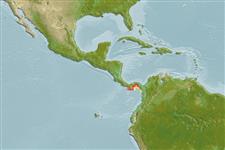Environment: milieu / climate zone / depth range / distribution range
Ecology
Marine; brackish; pelagic-neritic; depth range 0 - 50 m (Ref. 189). Tropical; 10°N - 5°N, 82°W - 77°W (Ref. 189)
Eastern Central Pacific: Panama Bay.
Size / Weight / Age
Maturity: Lm ? range ? - ? cm
Max length : 18.7 cm TL male/unsexed; (Ref. 114986); max. published weight: 49.80 g (Ref. 114986)
Dorsal spines (total): 0; Anal spines: 0; Anal soft rays: 28 - 35. Body somewhat compressed, moderately deep. Snout pointed, about 1/2 to 3/4 eye diameter; maxilla moderate, tip somewhat bluntly pointed, reaching to middle of inter-operculum; gill cover canals of panamensis-type. Anal fin long, its origin under or slightly before dorsal fin origin. A narrow silver stripe along flank, about pupil diameter.
Occurs in coastal waters, probably tolerating lowered salinities (as in A. mundeola). More data needed.
Life cycle and mating behavior
Maturity | Reproduction | Spawning | Eggs | Fecundity | Larvae
Spawn in school (Ref. 205).
Whitehead, P.J.P., G.J. Nelson and T. Wongratana, 1988. FAO Species Catalogue. Vol. 7. Clupeoid fishes of the world (Suborder Clupeoidei). An annotated and illustrated catalogue of the herrings, sardines, pilchards, sprats, shads, anchovies and wolf-herrings. FAO Fish. Synop. 125(7/2):305-579. Rome: FAO. (Ref. 189)
IUCN Red List Status (Ref. 130435: Version 2024-2)
Threat to humans
Harmless
Human uses
Fisheries: subsistence fisheries
Tools
Special reports
Download XML
Internet sources
Estimates based on models
Preferred temperature (Ref.
123201): 27 - 28.1, mean 27.9 °C (based on 10 cells).
Phylogenetic diversity index (Ref.
82804): PD
50 = 0.5000 [Uniqueness, from 0.5 = low to 2.0 = high].
Bayesian length-weight: a=0.00490 (0.00270 - 0.00889), b=3.16 (3.01 - 3.31), in cm total length, based on LWR estimates for this species & Genus-body shape (Ref.
93245).
Trophic level (Ref.
69278): 3.4 ±0.5 se; based on size and trophs of closest relatives
Resilience (Ref.
120179): High, minimum population doubling time less than 15 months (K=2.78).
Fishing Vulnerability (Ref.
59153): Low vulnerability (10 of 100).
